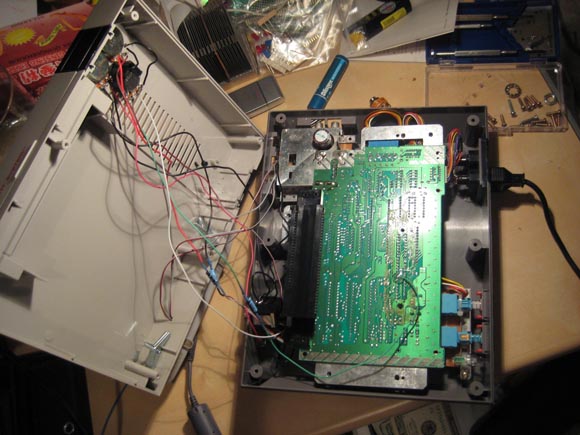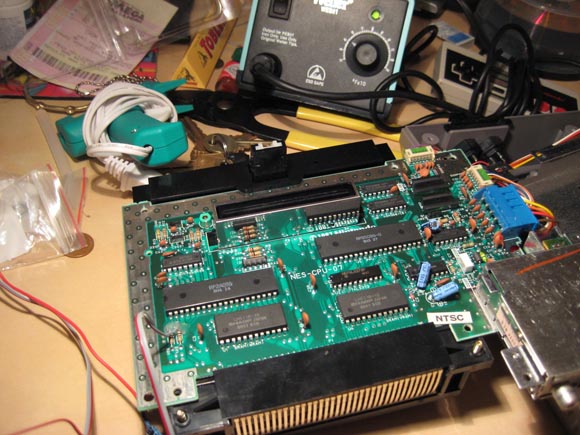Ed.: It’s more than nostalgia that drives the dedicated chip musician with their modified Nintendo instruments. As guest writer Vijith Assar learned while interviewing Anamanaguchi, some more elemental love of digital synthesis leads these artists to deal with esoteric hardware and crashing homebrewed software. Vijith covered Anamanaguchi for New York’s Village Voice, but this trio had far more geeking than could fit in the free weekly’s pages. The band’s front man and songwriter, flanked by talented NES hacker bandmates, muses on the technology and artistic process – and on why, yes, the act did have to start with blowing on the cartridges. (Surprised?) -PK
I recently had a chance to chat with Anamanaguchi, who would probably be the boy-band teen idols of the chiptune world if the scene were to tolerate such things. Lead songwriter Pete Berkman opened up about his creative process and the digital speed bumps he hits along the way, and guitarist Ary Warnaar is on another planet when it comes to working with Game Boy synths like LSDJ and Nanoloop, but the most freakish technical bits came from bassist James DeVito. He wrote later to describe in detail the customized hardware he’s cobbling together for use on tour, which so far has involved modding the Nintendo for multiple outputs, each with a bolted-on 1/4″ jack and volume knob, and integrating a tiny high-res screen lifted from a PlayStation. He’s even considering a built-in controller for the next version.
The stock NES has five channels of sound — two square waves (lead), triangle (usually for bass), noise, and DPCM sample channel. Normally, these are all mixed down to one mono output, but by tapping directly into pins 1 and 2 of the CPU, we are able to separate them into two outputs. Pin 1 on the NES CPU (2A03) contains the two square channels, and pin 2 contains the triangle, sample and noise channel. A third output is gained from a proprietary audio expansion, containing two extra square channels and a sawtooth channel. This particular one, VRC6, was designed by Konami and featured only on Japanese Famicom games. However, with development carts we are able to get the expansion audio on our NES. The extra audio chip is in the cartridge itself, and outputted directly through a pin on the cartridge. This pin is tied directly to pin 9 on the expansion port, which is where we tap in to get our third output. Directly off those pins I connected 1µf capacitors @ 50V (negative leg goes to CPU pin, positive goes to output) to protect the chips from any short circuits or power surges when plugging a cable in. From there it’s relatively simple, putting them in line with 50K pots and outputting directly to the 1/4 inch jacks out the back. The screen is all wired internally. 5V power is taken from the regulator within the screen and fed into the NES. In order to avoid problems, I cut out the 7805 regulator in the NES and applied the 5V where it needed to be. Audio and video were soldered directly to where the RCA jacks are attached to provide signal to the screen.
And what then? Well, let’s ask Pete.
Vijith: How do you do write these sequences?
Pete: It’s a [DOS] program called Nerdtracker 2 that apparently writes music in the language that the NES can understand. It’s a really home-brewed program. It was made in 1998 by a bunch of Swedish dudes, and it never got out of beta, and it’s prone to crashing, and it has all these terrible bugs in it, half the features don’t work.
And the decision to mix it with guitars?
Pete: I started messing around with it and sending songs back and forth with a friend of mine, and in the beginning, the music I wrote kind of sounded “videogamey,” but as I continued writing, my actual musical influence kind of started to get in there. And at that point, it made a lot of sense to put it as an instrument in a full live band setting, with guitars and drums and that sort of thing. Right before going to NYU, literally NYU move-in day, I released the Power Supply EP through 8bitpeoples, which I had recorded totally by myself at my house except for one track which we recorded with James. All I had was a shitty mic and a shitty guitar and a shitty amp and just recorded what I knew, without any kind of formal training.
It was made in 1998 by a bunch of Swedish dudes, and it never got out of beta, and it’s prone to crashing, and it has all these terrible bugs in it, half the features don’t work.
Do you write using a guitar or a Nintendo?
Pete: It’s a mixture of both. Certain songs, I’ll get the idea as a melody in my head. The music is pretty melodic, so it’s pretty transferable from instrument to instrument. Anything I write on guitar I can put on the Nintendo, and anything I write on the Nintendo I can usually play on guitar – unless it’s way too fast, which it usually is.
Recently, I’ve been getting more into making sounds on the Nintendo that can’t be reproduced by instruments, doing stuff that only the sound chip can do. But more or less I like to create a skeleton of the song on the NES. Ary, on the Game Boy, makes some absolutely ridiculous stuff that’s really fucking weird, like, really just straight-up the weirdest music I’ve ever heard. And the way he does it is not so much thinking musically, but technically. When I came into the 8-bit world, I was definitely the opposite. Any time there’s electronic music, you have people who are thinking technically, and usually that’s music that I’m not very interested in, because it’s kind of cold, usually. I came into the 8 bit world with a very musical background, being in bands growing up and stuff, as opposed to a programming background. But recently I’ve been getting really into making strange sounds on the Nintendo that, like, “Whoa, I didn’t know you could do that with that sound chip.” At the same time, I’m mixing that with that simple pop sensibility.
What I usually like to do is to harmonize everything. Why not? You have two square channels. What else are they going to do but harmonize each other?
James: You don’t have the option of chords, so you might as well harmonize.
Pete: I tend to get bored very easily, which kind of finds its way into the music too. Like, “Oh, here’s an idea. Oh, wait, no, it’s gone now. Now it’s totally different.” In high school, I guess I was diagnosed with ADD — whether that’s bullshit or not, which I think it is, but I’m very capricious, and I tend to jump from thing to thing, in life and in music. But yeah, basically, hyperactivity is something I do.
Basically, hyperactivity is something I do.
Basically, hyperactivity is something I do.
How does it actually work? All this time I thought it was a MidiNES, but I recently read a YouTube comment where you said that wasn’t the case.
Pete: Two years ago, I was really upset by the claim that it was MIDI, because it was such a ridiculous process that we don’t do anymore. Back then, you would make the song in Nerdtracker 2, and if you typed in a wrong filename and hit Enter, the program would just crash, and you’d lose everything you had worked on. From there, you’d have to hit Enter to create, like, four different files — temp.ihd, temp.dat, temp.dmc, and temp-dot-some-other-shit. And you’d take all those files and compile them in an NES compiler. That would give you a Nintendo Sound File. And you’d have to do this specifically in Windows 98, because the assembler for XP was fucked up, and it would give you the wrong shit, the wrong hex to burn onto a chip. What you would do from that point is turn it into a binary file, .nsf. The only command is “Play this song at this location in the EPROM’s memory.” And so what you would do from there is you would take that binary file and burn it to a special 28-pin EPROM chip that you would have to order in bulk from some electronics company in New Jersey. And then if you’re lucky, the burning worked. And then if you’re even luckier, all 28 pins are in place in the socket that you soldered into an NES cartridge. And then if you’re even luckier, the NES is willing to play the song in the cartridge — instead of having to blow on it — and then it plays. And that’s the process that we did live, with one chip for each different song, having to flip it out with a guitar pick and replace it with my shaky hands.
James: And the chips aren’t even labeled. So it was this long, complicated process.
Wait, isn’t that last problem your fault?
Pete: Yeah.
James: We’ve come a long way since then.
Pete: Yeah, we have come a long way. That’s why I was… not upset, but adamant about saying what it was. But we’ve got this new system that’s the happiest…
James [unzips case]
Pete: Yeah, we have it here. Instead of burning stuff to a chip, you just take the NSF and put it on a CompactFlash card, and put that in a cartridge that will straight-up just play the song, and has a menu. It’s a 2-gig Flash card, so you can put every song on there, and there’s an on-cartridge browser. And we have a screen hooked up to it, too.

James: The card is usually meant for development, but it also plays the Nintendo sound files that Pete exports, so we can actually just go through it and the file browser has all of our songs listed. (And every game we downloaded from a torrent.)
Ary: He’s currently working on a new Nintendo. They’re going to replace literally every electrical component.
James: Well, not everything. But just make it sound better, like improve the output.
You mean just gutting it and rebuilding it with better parts?
James: It’s more like rebuilding the audio output aspect of it, and certain things like the power supply that adds noise to the signal. It’ll have newer parts, so it’s less likely to explode on stage. With our old setup, if major vibrations were happening to it, it would actually just restart the song.
Pete: Tons of aberrations live.
Ary: And major vibrations happen a lot on stage…
Check out the band for yourself; they’re on tour now.
Vijith Assar is a musician, writer, and computer geek based in New York City. His musical projects have tended toward scores for film, television, and
advertising, and his writing has appeared in the Village Voice, the New York Post, Tape Op, Electronic Musician, and PopMatters, among others. He plays the Chapman Stick and might be going bald because of Reaktor.


